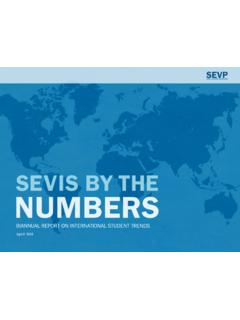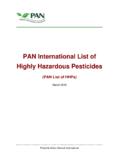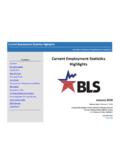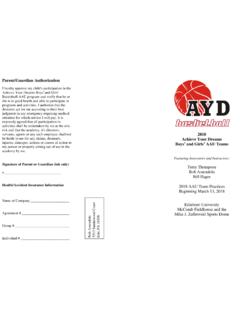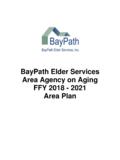Transcription of SECOND OIE GLOBAL CONFERENCE ON …
1 O I E 1 2 , r u e d e P r o n y 7 5 0 1 7 P a r i s F r a n c e T e l . : 3 3 ( 0 ) 1 4 4 1 5 1 8 8 8 F a x : 3 3 ( 0 ) 1 4 2 6 7 0 9 8 7 w w w . o i e . i n t o i e @ o i e . i n t SECOND OIE GLOBAL CONFERENCE ON antimicrobial resistance AND PRUDENT USE OF antimicrobial AGENTS IN ANIMALS: Putting Standards into Practice Marrakesh (Morocco), 29 - 31 October 2018 BACKGROUND There is a critical need to address the threat posed by antimicrobial resistance (AMR) to human, animal and environmental health. The significant scientific, economic and social challenges posed by AMR are now widely recognised by governments, the private sector, academia, organisations representing civil society, and increasingly consumers.
2 Strong multisectoral collaboration at an intergovernmental level has been instrumental in elevating awareness and initiating coordinated action. The Tripartite, a partnership between the OIE, the Food and Agriculture Organization of the United Nations (FAO), and the World Health Organization (WHO), has for many years worked together towards harmonised international standards, capacity building initiatives, and monitoring and evaluation to support responsible and prudent use of antimicrobials. In 2015, the GLOBAL Action Plan on antimicrobial resistance (AMR) was unanimously endorsed by the Membership of the three organisations, outlining the responsibilities of all stakeholders across sectors in combatting this GLOBAL issue through a One Health approach.
3 The Tripartite also promotes a One Health approach through the activities of the Interagency Coordination Group on antimicrobial resistance , formed by the United Nations in 2016. Antimicrobials agents are essential tools for protecting animal health and welfare. They also contribute to satisfying the increasing world demand for safe and humanely produced food of animal origin. To ensure sustainability of livestock production and maintenance of animal welfare for terrestrial and aquatic animals, the efficacy of antimicrobial agents must be preserved through their responsible and prudent use.
4 As the recognised GLOBAL leader on animal health and welfare, the OIE engages in the fight against antimicrobial resistance through standard setting for and capacity building of Veterinary Services, livestock producers, and other stakeholders of the animal production industry. These activities are outlined in the four objectives of The OIE Strategy on antimicrobial resistance and the Prudent Use of Antimicrobials, and reflect the principles of the GLOBAL Action Plan on AMR. The objectives are: 1) Improve awareness and understanding; 2) Strengthen knowledge through surveillance and research; 3) Support good governance and capacity building; 4) Encourage implementation of international standards.
5 Following the first OIE GLOBAL CONFERENCE on the Responsible and Prudent Use of antimicrobial Agents for Animals (13-15 March 2013), recommendations of this important meeting led directly to continued capacity building in Member Countries through the OIE PVS pathway, strengthened collaboration with WHO and FAO through the tripartite alliance, and the creation of the first GLOBAL database on the use of antimicrobial agents in animals. Since this time, OIE monitoring activities have demonstrated impressive progress in its Member Countries towards combatting AMR in animals. In 2012, an OIE questionnaire showed that 27% of the 152 responding Member Countries had an official system in place for collecting quantitative data on antimicrobial agents used in animals.
6 By the SECOND phase of the OIE data collection on antimicrobial agents intended for use in animals, concluded in May 2016, 73% (107 out of 146 countries that replied) were able to provide quantitative data on antimicrobial agents intended for use in animals. The results of Technical Item 1 of the 85th OIE General Session in 2017, GLOBAL action to alleviate the threat of antimicrobial resistance : progress and opportunities for future activities under the One Health initiative also highlighted areas of development in Member Countries. The percentage of Member Countries declaring no significant awareness-raising activities on AMR fell from 46% (before 2015) to 22% (after 2015).
7 The proportion of Member Countries reporting no data collection on antimicrobial use in animals fell from 31% to 19% after 2015. In the same period, the proportion of Member Countries without a regular national AMR surveillance system or plan fell from 44% to 25%. Only 7% of reporting countries declared not having put in place any policy or legislation on the quality, efficacy and safety of medicinal products, and an increase was shown in use of OIE international standards and guidelines on antimicrobials across all OIE Regions. These remarkable improvements demonstrate the significant impact a harmonised intergovernmental approach can achieve in tackling this GLOBAL issue, while also highlighting areas where future growth is needed.
8 Current work on antimicrobial resistance focuses primarily on antibiotics, while data shows that resistance to antiparasitics is of growing concern to animal health, welfare and productivity. Country reporting in monitoring and evaluation by the OIE and its Tripartite partners has also underscored the problem of substandard and falsified veterinary antimicrobials, which escape government regulation and surveillance aimed at reducing development of antimicrobial resistance , and with unknown contents, pose a risk to animal and human health. To ensure a successful, harmonised and sustained response to antimicrobial resistance , international standards must be implemented at all levels, and in all areas regarding animal health and production.
9 As Member Countries work to implement OIE standards nationally, engagement is essential from all stakeholders, such as the veterinary pharmaceutical industry, wholesale and retail distributors of veterinary antimicrobials, animal feed manufacturers, and veterinarians and food animal producers in the field. Achieving agreement and collaboration The CONFERENCE website is currently under development between these diverse and relevant stakeholders is the next step in capacity building on a national level. To achieve measurable results at the GLOBAL , regional and at country levels, the OIE and Member Countries should ensure strong engagement and communication between, and training of, these different sectors of the animal health industry.
10 Within the animal health sector at a national level, a strong Veterinary Authority must ensure a comprehensive understanding and effective collaboration across the Veterinary Service, ensuring veterinarians, farmers, feed and pharmaceutical industries, are committed and engaged in the National Action Plan, each understanding their role, and are supported in developing the required competencies to achieve the shared goal of reducing development and spread of antimicrobial resistance . The Veterinary Service must build and sustain effective One Health partnerships at a national level.










